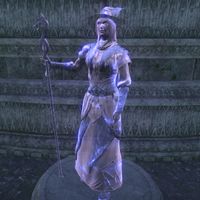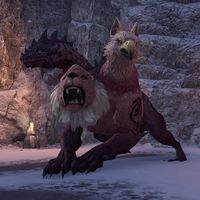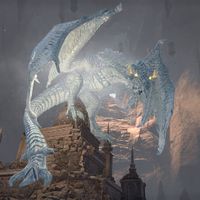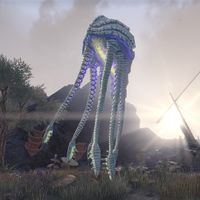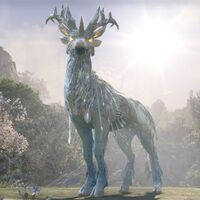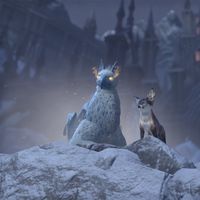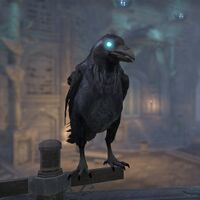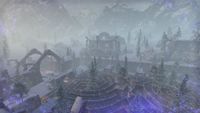Lore:Luminary
The Luminaries of Magic (Luminaries for short) are mysterious immortal beings of pure magic, spirits likened to beams of sunlight from Magnus himself.[1][2] that are described with the Old Bretic word Alien meaning "stranger". This is due to the fact that they see the world and magic differently from mortal-kind, and no one, not even the Luminaries themselves, know what they actually are.[3] The Luminaries played an important role in the life of Archmage Ulfsild the Evergreen, collaborating with her alongside the other Luminaries to develop the system of Scribing, a "metamagical theoryset"[4] that was the precursor to the modern Spellcrafting system.[5][1][UOL 1]
They have however chosen the forms and names of various creatures from Nirn that suit their personalities.[1][6] The Netch chose its form for its buoyancy and its ability to direct the currents of magicka through the air via its tentacles,[7][8] while the Gryphon wishing to serve as a peacekeeper took on the shape of a creature that is often found in symbols predating mankind and has symbolized justice.[9] The Dragon chose its form for its majesty,[2] while the Indrik claims there was simply no other form it could have been.[6] The name for them, "Luminaries of Magic", was given to them by Ulfsild the Evergreen, who viewed them as "lights in the dark".[1]
The Indrik was the first of the Luminaries to come into existence, and is considered more powerful than the rest, whereas the Luminary Crow is the youngest "by far".[1][6] The Gryphon is older than the Luminary Netch, but younger than the Luminary Indrik.[9]
All Luminaries have their own realms that were formed alongside them at the time of their birth, shaped and hewn into being by them in a manner similar to that with which they chose their forms.[1][6][9][2][7] The realms of all Luminaries have warded doors and keys which one has to use to enter them.[1]
As beings of pure magic the Luminaries are said to understand magic in a way mortals never could and so, their power, freely given, allows one to access arcane mysteries most could only dream of. Indeed, Scribing is said to have been somehow destined to channel the power of the Luminaries from the start.[1][6]
Luminaries are said to possess a mastery of magic that makes the average archmage look like a neophyte. As Luminaries, they see the world and magic in a way that is different from mortals, and so are not particularly fond of mages and will only lend them their power if their challenges are completed.[1][3] The great magical power of each Luminary can impact magic across Tamriel, reverberating and causing new Ley Line activity across the land while also making the arcane components of Scribing manifest in many places in the world.[6][10][11][12][13] Indeed, the strength of the Luminaries is described as capable of rewriting magic, thus allowing the Scribing Altar fueled by their might to achieve incredible feats of magic, allowing it to "shape the very heart of magic itself" and translate its very essence into mortal hands with the Luminary as the intermediary, thereby changing, or rewriting, both the magic and the mortal, as the practicioner scrawls their soul upon the page.[1][6]
Despite their great power, even Luminaries are considered no match for the might of a Daedric Prince and, though they can halt the passage of a soul to the afterlife, they can do so only temporarily[14][1][15][7]
Origin and Nature[edit]
There are many theories regarding the origins of the Luminaries, who are generally thought to bear some relation to Aetherius. They have been theorized to be fallen tears of Aetherius formed of its energy manifested in physical form, new lifeforms that arose naturally from the meeting of life and aetherial energy, "children" or creations of the Aedra that were sent as their proxies to herald their return and guide mortals, and are to Aetherius what the Daedra are to Oblivion, aetheric constructs born from the imprinting of the subconscious eidolons of mortals upon purest magicka, a natural part of the cycle of magic that functions as the mechanism by which it is emanated to the mortal world akin to a lamp casting light or an aqueduct carrying water, Daedra in disguise, or ascended ancestor spirits, the souls of dead mortals that have taken on a new form.[1][3][5]
The Luminaries of Magic also have their own opinions on how they came to be, each with contradictory answers.
The Indrik believes the Luminaries to be eddies in the current of the river that is magic, not masters of it, but part of it, who are one with it as much as it is one with them,[6] and believes himself to have been created as a manifestation of pure thought, the invention of a mind that craved to make sense of the world through stories.[5]
The Gryphon believes himself to have been born as a result of the death of another, a great sage who stood against a terrible enemy and burned them out from within using a mighty and beautiful spell that cost them their life. He thought that the casting of the fatal spell required a lengthy ritual and a vast amount of magicka accumulated during that process, so great that, when the spell was finished, a great reservoir still remained to coalesce into the Gryphon himself.
The Dragon believes herself to have been born from the ebb and flow of Aetherius and Nirn, from a confluence of magic beyond mortal influence, and refuses to consider her birth the result of events such as a magical accident or a summoning gone awry. Being asked questions on her birth angers her, and she is willing to argue at length over the topic.[5][2]
The Netch believes itself to have been born from an accident of magic, an event that was "deeply boring". Viewing its birth in this manner was what prompted it to always be "joyous and floaty", as it believes existence is what one makes of it. When asked of its birth, the Netch was known to rotate through many different tales, one of which involved a wizened scholar tracing arcane runes for a detailed summoning, though by the Netch's own admission, it was only joking when speaking such stories.[7][5][2]
Unlike the other Luminaries, the Crow was an intentional creation of Archmage Ulfsild the Evergreen, who, partly inspired by The Gryphon's beliefs regarding his own origins,[5] used part of her own soul in a ritual that combined her spirit and a copy of her mind from that moment in time, flashing them upon the great wellspring of arcane power she'd gathered in the Scholarium's Scribing Altar, to create a new Luminary of Magic, a ritual described as the ultimate act of Scribing. As the looming threat of the loss of Eyevea left little time to plan the ritual to Ulfsild's normally exacting standards, the process was not fully refined, causing the Crow to have a chaotic arcane presence. The ritual to create the Crow took an enormous toll upon Ulfsild's spirit, siphoning a considerable amount of her soul. However, though it took years, her spirit eventually recovered.[1][16][17]
History[edit]
First Era[edit]
Meeting Ulfsild the Evergreen[edit]
Though she did not know it at the time, Ulfsild had met the Indrik Luminary in her youth, who saved her from being trampled from a herd of mammoths that she had attempted to collect wool from. The Indrik lifted Ulfsild onto his back as she was about to be trampled, and deposited her to safety before vanishing. Ulfsild's clan laughed at her thinking she had some fanciful dream, and all that was left to show was the Indrik's feather which she kept as an accessory on her hat as a keepsake. [18]
Circa 1E 2250,[3][19] Ulfsild came into possession of the Fable of the Indrik. Ulfsild, who had the ability to see te currents of magicka with her own eyes, noticed an essence around the book, similar to the one that made up the feather she'd kept from her youth. She annotated the text and used its clues to discover the gateway to the Indrik's realm.[20] She obtained the keys from various locations on the island of Auridon—near the mundus stone dedicated to the Lady south of Silsailen, in Ondil, and Buraniim. Ultimately, she found the door on the island of the South Beacon lighthouse. After breaking the wards and trespassing into the Indrik's domain, Ulfsild made a wager. If she could prevent him from reclaiming the feather that had fallen from him long ago, he would share his knowledge and power with her and, if she could not, she would depart his domain and leave him in peace.[1] Ulfsild passed the trial, and formed a bond with the Indrik.[21] This bond eventually led to the connection of the realm with the Scholarium, located beneath the isle of Eyevea, the two places bound together by the Indrik itself.[6]
At some point after 1E 2250, when Ulfsild had already located the Wing of the Indrik, she'd also encounter the Gryphon.[3][19][21] Ulfsild was studying in the Scholarium, beneath the island of Eyevea.[1] As she was reflecting on a childhood memory, a fox stole her faerite gem and darted through a wall, leading her to stumble into a snow drift and into the realm of the Gryphon. Saved by the Gryphon's protective instincts, Ulfsild came to understand that both the Fox and Gryphon were playful and nurturing creatures, akin to a mischievous child and its protective parent. She observed the fox playing with her faerite and later found herself waking up warmly sheltered under the gryphon's wings.[22]
Later, after Ulfsild had already located the Wing of the Indrik and the Wing of the Gryphon, she'd also encounter the Netch.[3][19][21] While studying in the great library of the Scholarium beneath Eyevea,[1] Ulfsild felt something tugging at her skirt. Expecting The Fox, she turned around but found nothing. Nonetheless she suddenly felt lighter, as if whatever force had tugged her skirt simply wanted her to look up and was playing a game. The event repeated twice, but nothing showed itself. The next day Ulfsild found her books arranged in the shape of a giant squirrel. The tugging soon returned, but Ulfsild ignored it. The playful presence than lifted the book she held from her hands, prompting her to chase it. The chase brought Ulfsild to an abandoned room, within which she felt an air of power, less serious than either The Gryphon or The Indrik. The space was like the room of a child or the studio of an artist, full of creativity and joy. Upon entering, Ulfsild suddenly found herself in a seaside domain bathed in sunlight. Within she found a large glowing netch, bobbing joyfully in the breeze. Knowing the Luminary meant her no harm, Ulfsild approached the creature, which welcomed her as a friend.[23]
At some point after 1E 2250, when Ulfsild had already located the Wing of the Indrik, she'd also encounter the Dragon.[3][19][21] Ulfsild heard the Fable of Mizbi and the Dragon from a Moon-Singer while travelling with a band of nomads through Malabal Tor. She immediately knew there was more to the tale, and spent the night sleepless thinking on it. Wandering from the campsite, Ulfsild found a young Cathay Khajiit gazing up at the stars. Being asked why he was awake, the Khajiit responded with a question, wondering if "she" could see him, the one who raises her gaze twice a night from under the galloping hooves of the Steed constellation. Ulfsild surmised that the Khajiit was speaking of the Twilight Star, of Azura. The Khajiit than offered to trade a polished moonstone for the feather of the Luminary Indrik on Ulfsild's hat. Ulfsild refused, as she'd had the feather since she was a child and it was very dear to her, and she recounted the Fable of the Indrik instead. Behaving as if she'd won some sort of game they'd been playing, the Khajiit once more offered up the moonstone as a fair trade for the story he'd been told. When Ulfsild tried to hand the moonstone back, he refused to take it, claiming instead she could give it back in exchange for another story or riddle. Wishing to learn more of the fable of Mizbi, Ulfsild asked the Khajiit to tell it to her again, writing down notes in the process, as she knew the story was the key to finding The Dragon.[24] Ulfsild annotated the text and used its clues to discover the gateway to the Dragon's realm. She obtained the keys from various locations, from the temple of Jode's Light, from the Do'Krin Monastery , from Khaj'Rawlith, and from Ja'zennji Siir to the west of Dune. Ultimately she found the door in a grove south of Willowgrove village, she broke the wards and entered the dragon's domain.[25] When Ulfsild encountered The Dragon she asked her a question. What is the thing that in order to have, you must give it up. The answer was an impossible riddle, and that was what the dragon wanted if she was to lend her power. Ulfsild could not give the dragon an impossible riddle, but she could give her a paradox. If she scribed a grimoire that could also scribe out every other possible grimoire, would it eventually also create itself ? The two argued over the question for hours and, eventually, the dragon conceded. Ulfsild passed the trial, and formed a bond with the Dragon, who lent her power, thus changing Ulfsild's magic forever.[26]
The Birth of Scribing[edit]
Ulfsild and the Luminaries collaborated duringn the creation of Scribing.
Before the doors to their wings were sealed, the Luminaries fed the altar their strength. With their strength fueling it, the altar could achieve incredible feats of magic, allowing it to "shape the very heart of magic itself" and translate its very essence into mortal hands with the Luminary as the intermediary, thereby changing, or rewriting, both the magic and the mortal, as the practicioner scrawled their soul upon the page.[1][6]
The power of the Indrik infused every drop of ink, every sheet of parchment, every whorl and dot upon the pages of the texts used for the Scribing process.[6] The Gryphon, sure in himself and direct in his actions, was associated with the development of Focus Scripts, arcane scripts which defined what effect the Scribed magic would have. During this time, Ulfsild and the Gryphon also came up with an idea to create animated constructs based on Ulfsild's own designs, that would serve as guardians of the Scholarium, though their vision was not realized at the time.[27][9] The Netch worked with Ulfsild to create the Luminous Ink, the substrate of power into which the magic of the Scribing altar was vested, and served as the binding agent that drew magicka and intent together upon the page.[27] The Dragon, keen of mind and eager to listen, was associated with the development of Signature elements, Scripts that could adapt to the magical and fighting styles of the person holding the parchment, named for all the ways in which Scribing could interact with the goals and magics of other disciplines that Ulfsild had discovered. A concept originally thought up by The Dragon herself, Signature Scripts were ultimately not fully completed in Ulfsild's time.[27]
Loss of Eyevea[edit]
At some point after 1E 2250, [3][19][21] the Scholarium was lost along with Eyevea, which it was located under, transported to the Shivering Isles due to a bargain Shalidor made with the Daedric Prince Sheogorath in exchange for the Folium Discognitum.[1][28]
Knowing that nothing she or the Luminaries could do would outpace the greed of a Daedric Prince, Ulfsild first froze the Luminary Gryphon in a tempest of ice, the magic of which she tied to a ward she left behind. This prevented the enraged Luminary from confronting Sheogorath, a being against whom even he was no match, while also preventing the Prince from discovering the Scholarium and Luminaries, which would've been disastrous.[9][29][14][1][15][30]
Ulfsild than used what time she had to enact a final plan meant to assure that Scribing would not become lost to the world. She used part of her own soul in a ritual that combined her spirit and a copy of her mind from that moment in time, flashing them upon the great wellspring of arcane power she'd gathered in the Scholarium's Scribing Altar, to create a new Luminary of Magic through a ritual described as the ultimate act of Scribing.[1][16][17] Thus the Luminary Crow was born. With her birth she chose the shape of her physical form, and her personal realm, the Wing of the Crow was also shaped and hewn into existence in the same manner.[6][1]
Before Sheogorath pulled the island out of Nirn, Ulfsild in an effort to preserve her life's work recorded the secrets on how to scribe within the library of the Scholarium.[31] In the event that the Scholarium were to be recovered, she left whoever would don the role as her successor, and emphasized they seek out the Luminaries that would continue guarding the place.[32]
With the doors closed, the altar became dormant. Without that beating heart, the mastery of Scribing was believed to stagnate.[1] The Scholarium itself was not discovered, however, for it had been warded against mages, Princes, and powers, long ago, and those defenses held strong even in the Shivering Isles. The Crow did not have much time to speak with Ulfsild, her other self, before the doors were sealed.[1]
Ulfsild left numerous messages for potential future inheritors of the lost art of Scribing, and creating Echoes. They were magical projections of herself with messages for future spell creators within the Scholarium and Sunnamere. These instructional illusions, scattered throughout the library, were meant to guide the inheritor through the process of contacting the Luminaries.[1] Among the known visages of her were the Flickering Image, and Ulfsild's Echoes of Introduction, the Lens, Regret, the Dragon, Loyalty, Mystery, Charity, the Final Trial, and of the Netch.[33]
Second Era[edit]
Rediscovery of Scribing[edit]
In 2E 582, either before or after Eyevea was returned to Tamriel by Shalidor and the Mages Guild, the Scholarium was rediscovered by a group of knights from the Order of the Lamp. During their arrival, complications arose, necessitating the sealing of the doors to prevent a catastrophe, as the once dormant altar became unstable, threatening the lives of everyone present. The disaster was prevented due to the intervention of the Vestige, who replaced the unstable focusing crystal. This potentially also prevented the discovery of the Scholarium by Sheogorath, an event which would've been catastrophic.[1][34]
After the magic was calmed, the Scholarium's caretaker, the Luminary Crow, directed the Vestige to seek out the other Luminaries and gain their support in order to return their strength to the altar. An act equated to inheriting Ulfsild's legacy and leaving a mark on spellcraft itself.[1]
The Inheritor of the Scholarium retraced Ulfsild's footsteps, guided by her echoes and the True Sight Lens she'd left behind to allow them to see magicka and Ley Lines with their eyes, as she could, discovering the fable and keys, breaking the wards, and entering the Wings of the Indrik, the Dragon, the Gryphon, and the Netch, to reconnect the Scholarium with them. The Luminaries gave the Inheritor a series of challenges to complete in order to prove themselves as Ulfsild's Inheritor. After their tasks were completed, the Luminaries agreed to lend their power.[2][7][9][6][1]
With their trials completed, the Luminaries granted their Sigils to the Inheritor. Placed at the altar, the Sigils restored the connection between the realms of the Luminaries and the Scholarium, and their strength flowed into the altar once more.[2][35][36][29][37] With their strength fueling it, the altar could once more achieve incredible feats of magic, allowing it to "shape the very heart of magic itself" and translate its very essence into mortal hands with the Luminary as the intermediary, thereby changing, or rewriting, both the magic and the mortal, as the practicioner scrawled their soul upon the page.[1][6] This reconnection led to the great power of the Luminaries causing new Ley Line activity across Tamriel, thus making Affix Scripts, Signature Scripts and Luminous Ink appear across the land[6][10][11][12][13]
With the support of the other Luminaries now assured, the Crow revealed the truth. She was the final Luminary, created by Ulfsild herself, and the last who could lend her power to the Scribing Altar. The chaotic magic that had originally led to the rediscovery of the Scholarium was a result of the Crow's own presence, as Ulfsild's ritual had never been fully refined due to the urgency of the situation not allowing enough time for it.[1]
In the Wing of the Crow the Vestige underwent the final trial to be declared the inheritor of Ulfsild's legacy. Within the Luminary Crow's replica of Labyrinthian. the Inheritor bested the Chimera Aut'arioth, which the Crow had summoned to serve as the final challenge. The Dragon and the other Luminaries than appeared, and acknowledged the Vestige as the inheritor of Ulfsild's legacy. With the final test completed, the Crow guided the Inheritor to retrieve her own Sigil, which Ulfsild had taken with her when she departed, so it too could be added to the Scribing Altar, amplifying its power further.[2][38] Knowing the Inheritor had other adventures calling to them, the Crow chose Order of the Lamp Votary Nahlia to act as the Scholarium's new caretaker. Thus Scribing returned to Tamriel.[1][34]
Vanus Galerion was particularly enthusiastic of the possibilities it would open up, with early ideas being altars being installed in every guild hall, or that Scribing will perhaps one day be taught in the wilds.[3] The legacy of Ulfsild's lived on, with Scribing eventually evolving into the modern Spellcrafting systems.[UOL 1]
Known Luminaries[edit]
Associated Realms[edit]
References[edit]
- ^ a b c d e f g h i j k l m n o p q r s t u v w x y z aa ab ac ad The Crow's dialogue in ESO
- ^ a b c d e f g h The Dragon's dialogue in ESO
- ^ a b c d e f g h i Loremaster's Archive - Scribing — Votary Nahila
- ^ The Largesse of the Archmagister in ESO
- ^ a b c d e f Ulfsild's Notes: The Origin of Luminaries — Ulfsild
- ^ a b c d e f g h i j k l m n o The Indrik's dialogue in ESO
- ^ a b c d e The Netch's dialogue in ESO
- ^ The Secret of the Netch — The Netch
- ^ a b c d e f The Gryphon's dialogue in ESO
- ^ a b Sigil of the Dragon Analysis in ESO
- ^ a b Sigil of the Indrik Analysis in ESO
- ^ a b Sigil of the Gryphon Analysis in ESO
- ^ a b Sigil of the Netch Analysis in ESO
- ^ a b The Fox's dialogue in ESO
- ^ a b Ulfisild's Echo of Regret's dialogue in ESO
- ^ a b Fable of the Crow
- ^ a b Ulfsild the Evergreen's dialogue in ESO
- ^ Ulfsild's Log: The Indrik — Ulfsild
- ^ a b c d e Mages Guild Charter
- ^ Fable of the Indrik (Annotated)
- ^ a b c d e Ulfsild's Log: The Indrik — Ulfsild
- ^ Ulfsild's Log: The Gryphon and the Fox — Ulfsild
- ^ Ulfsild's Log: The Netch — Ulfsild
- ^ Ulfsild's Log: The Dragon — Ulfsild
- ^ Fable of the Dragon (Annotated)
- ^ Ulfsild's Notes: The Impossible Riddle — Ulfsild
- ^ a b c How to Scribe in ESO
- ^ Arch-Mage Shalidor's dialogue in ESO
- ^ a b The Wing of the Gryphon quest in ESO: Gold Road
- ^ Ulfisild's Echo of Loyalty's dialogue in ESO
- ^ How to Scribe — Ulfsild
- ^ Ulfsild's Log: Your Discovery, My Farewell — Ulfsild
- ^ Flickering Image, Ulfsild's Echo of Introduction, Ulfsild's Echo of the Lens, Ulfsild's Echo of Regret, Ulfsild's Echo of the Dragon, Ulfsild's Echo of Loyalty, Ulfsild's Echo of Mystery, Ulfsild's Echo of Charity, Ulfsild's Echo of the Final Trial, and Ulfsild's Echo of the Netch's dialogue in ESO
- ^ a b The Second Era of Scribing quest in ESO: Gold Road
- ^ The Wing of the Dragon quest in ESO: Gold Road
- ^ The Wing of the Indrik quest in ESO: Gold Road
- ^ The Wing of the Netch quest in ESO: Gold Road
- ^ The Wing of the Crow quest in ESO: Gold Road
Note: The following references are considered to be unofficial sources. They are included to round off this article and may not be authoritative or conclusive.
| |||||||||||
| |||||||||||||||||||||||||||||||||||||||||||

